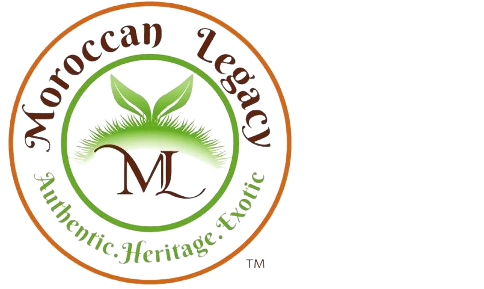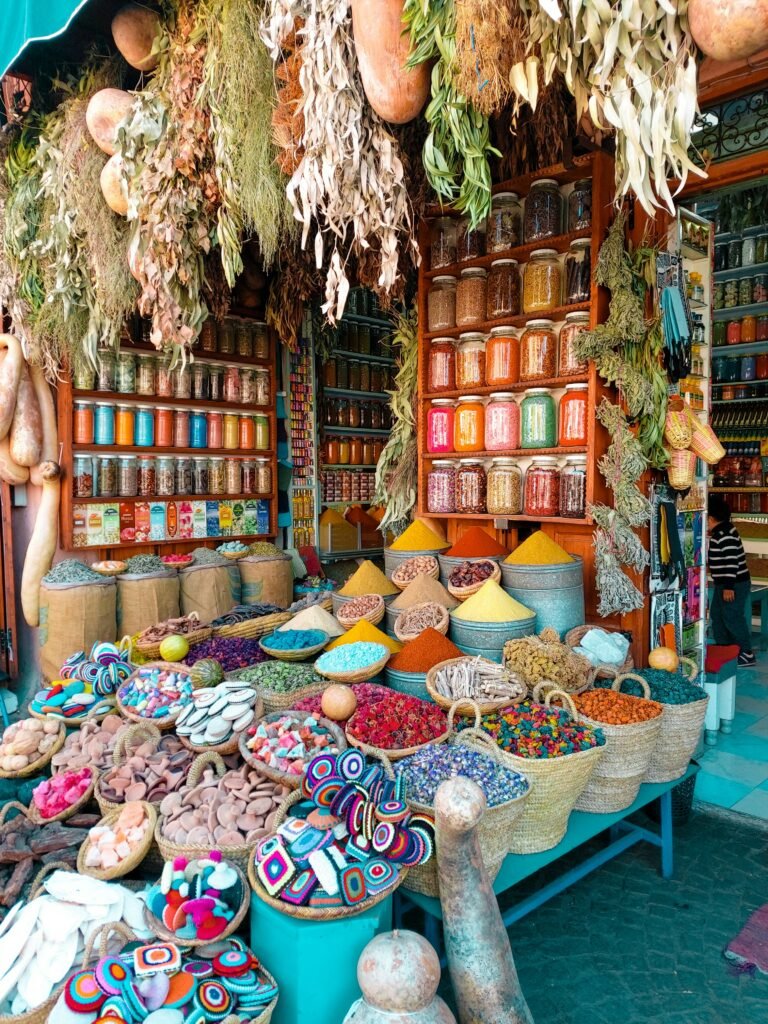Introduction
Marrakech’s Souks: Morocco possesses a rich cultural heritage that has endured for centuries. This North African country retains a magical aura from the north’s mountainous regions to the south’s sandy deserts. Marrakech, one of Morocco’s four royal cities, contains a compelling mix of Mediterranean and desert influences in its architecture, cuisine, and crafts. At the heart of Marrakech’s appeal lies its bustling souks – colorful markets packed with traders selling diverse goods. Wandering through these covered alleys is like taking a step back in time. Beyond shopping for Moroccan specialties, exploring the souks offers cultural insights into Moroccan society, traditions, and artisanship.
This blog post aims to provide a personal perspective on experiencing Marrakech’s renowned souks. I will describe my impressions of various markets and highlight some of the items traders sell. By delving into the history and cultural significance of these shopping destinations, I hope to convey their charm as lively works of folk art. With rich anecdotes and human-centered insights, I aim to help readers feel transported to this magical realm through vivid storytelling. I also touch on sustainability issues and efforts to preserve craft traditions for future generations. I invite you to join me on a visual journey to discover the diverse tapestry woven throughout Marrakech’s vibrant souks.
Marrakech’s Souks: The Spice Souk and Aromas of the Medina
I explored Marrakech’s markets at the bustling Spice Souk, just inside the medina walls. As I wandered through the narrow alleyways, an irresistible blend of smells wafted through the air – cinnamon, saffron, ginger, mint, and more. Market stalls displayed colorful pyramids of dried goods as traders called out to passersby, enthusiastically presenting their wares. The heady aromas triggered memories and brought exotic flavors to life.
I stopped to chat with a grinning spice merchant named Ahmed, who proudly arranged mounds of turmeric, cumin, paprika, and other seasonings. “These spices have nourished Moroccan cuisine for centuries,” he told me. “Our tagines and pastillas would not taste the same without them!” I could sense his deep passion for food and culture as Ahmed gestured animatedly, describing savory and sweet recipes. His lively performance also seemed aimed at attracting customers browsing the crowded stalls.
Wandering further through the maze-like souk, I noticed shops dedicated to selling tea or herbs for traditional Moroccan medicine. Artisans hand-pounded tea leaves or sorted dried plants with great concentration. Within these intimate spaces, ancient healing practices still thrive alongside modern life. Traversing the Spice Souk was a refreshing sensory exploration, bringing me closer to Moroccan culinary traditions and wellness practices rooted in natural remedies. The lively merchant interactions also demonstrated how commerce and cultural transmission interconnect within these colorful markets.
Marrakech’s Souks: The Coppersmiths’ Souk and A Clanging Symphony
My second stop was the Coppersmiths’ Souk, where artisans hammer intricately engraved trays, pots, bowls, and lamps from sheets of copper. As I strolled down the narrow lane, an incredible din assaulted my ears – an upbeat symphony of clanging, hammering, and welding.
Peering into open workshops, I watched nimble artisans shaping gleaming metal over anvils, sparks flying with each impact of the hammer on copper. Finished pieces lined exterior stalls, their surfaces etched with abstract floral designs or geometric motifs that have changed little over the centuries.
I paused to observe one smith, Mustapha, who worked steadily, pounding out the base of an ornate tray. Noticing my interest, he smiled and invited me inside to watch the intricate process up close. As Mustapha shaped the copper with practiced strokes, he narrated each step – hammering the surface smooth, applying resist wax for etching, dipping in acid to burn away unprotected areas—a dancing floral pattern as lacy and complex as Moroccan tilework emerged. Mustapha proudly told me he came from a long line of coppersmiths, continuing traditions passed down for generations.
Witnessing such exceptional artistry and hearing Mustapha’s dedication to craft left me in awe. I realized that the deafening din of hammering echoed centuries of skills preserving Morocco’s cultural heritage. The coppersmiths’ souk highlighted how local artisans breathe new life into traditions while welcoming outsiders to observe their artistic process. History, art, and commerce unite harmoniously in this bustling commercial and creative quarter.
Marrakech’s Souks: The Leather Tanners and A Pungent Alchemy
To witness more of Marrakech’s tradition-steeped trades, I ventured south of the Medina to the bustling Leather Tanners district along the Oued El Hammam River. I steeled myself upon arriving, confronted by a thick, distinctive odor. Here, dyers immerse raw hides in vats of pungent concoctions like dried flowers, water, quicklime, and urine to nourish and tan the leather. It’s an alchemical process unchanged for eons, transforming hides into materials for crafting bags, belts, shoes, and more.
Despite the nose-wrinkling smells, watching the skilled workers was undeniably fascinating. One kindly tanner, Hussein, walked me through the multi-day procedure. He sun-dried fresh hides treated them with quicklime and urine solution, then repeatedly massaged and stretched the stiffening material – coaxing suppleness from what were once tough animal skins. Hussein’s nimble hands and eye for quality exemplified mastery over centuries-old methods.
While the tanning district’s sensory intensity initially shocked me, I soon grew appreciative of witnessing such an essential craft preserved from antiquity. This industrial yet traditional neighborhood demonstrated how local trades integrate modern life while respecting ancient practices. Most importantly, the tanners play a vital rural role – converting byproducts into valuable goods supporting craft traditions and Morocco’s economy as a whole. Their perseverance ensures this age-old process endures for future artisans.
The Artisans’ Markets: Preserving Cultural Patrimony
Beyond goods for culinary or household use, Marrakech’s souks offer a treasure trove of handicrafts reflecting Berber and Islamic design aesthetics. A dazzling array captivated my senses while wandering the Artisans’ Markets near the Medina’s northern ramparts. Intricately carved and painted woodwork, ceramics glazed in vibrant hues, embroidered fabrics, and jewel-toned furnishings filled stalls as far as the eye could see.
I lingered at one shop where a woman wove kilims – flat-woven rugs featuring geometric patterns passed down through generations. She explained how designs reference tribal origins or signify meanings like protection and fertility. Nearby, Fatima’s younger ceramicist showed me her painted pots and tiles inscribed with Arabic script adorned with paisley motifs. Both conveyed great pride in reviving ancestral techniques while innovating with modern styles. Their pieces beautifully fused tradition with global tastes – ensuring cultural skills outlive recent memory.
Many artisans consciously share knowledge in a communal effort to sustain these professions for the coming generations. Cooperatives support rural women crafting textiles to earn a fair living despite limited opportunities. Groups also promote environmental awareness – employing natural dyes and local materials rather than synthetic ones. Witnessing such devotion to safeguarding cultural patrimony left me inspired and hopeful for traditions’ long-term survival despite social changes. In these markets, the past retains relevance through constant artistic reinvention.
Marrakech’s Souks: The Souks’ Living Museum
Throughout my meandering journeys within Marrakech’s souks, what moved me most wasn’t any single item purchased but rather immersed in a vibrant showcase of Morocco’s extensive cultural heritage. Within the markets’ labyrinthine passages, the past firmly anchors the present as centuries-old practices still shape everyday life. Artisans preserve skills with care and zeal as palpable as the scents wafting through the spice stalls. Seeing families proudly continuing traditions passed through generations heartened me with the souks’ continuity despite societal transformations.
Overall, I came to view these bustling markets as a sprawling open-air “living museum” where history resides not behind ropes and glass but within practical working spaces. Craftspeople’s demonstrations highlight techniques evolving organically while honoring fundamentals. The souks unite commerce and cultural transmission – each sale sustains an artist while spreading appreciation for intricate creations. Visitors gain unique access to diverse perspectives usually reserved for insiders through chance encounters with welcoming locals.
Most significantly, the souks showcase how traditions adapt to new contexts without compromising the essence or quality of craftsmanship. This delicate balance between preservation and progress lifts one’s spirits with the hope culture might endure social changes. Hence, strolling Marrakech’s souks instills familiarity with Moroccan handicrafts and a profound respect for communities thoughtfully preserving their richly woven cultural tapestry’s vibrant colors for generations.
- Navigation is half the experience – The maze-like layout ensures visitors wander serendipitously through narrow alleyways, discovering hidden treasures around every bend. Getting lost and exploring without rigid itineraries enhances interactions.
- Bargaining is a tradition – Part of the shopping fun is friendly haggling over prices. Traders start high and buyers low, eventually meeting in the middle. It’s more about the lively banter than getting the absolute lowest cost.
- Local crafts showcase Berber heritage – Rural Berber artisans constitute a majority of souk traders. Their wood carvings, pottery, carpets, and textiles reflect ancestral nomadic traditions with symbolism stemming from nature.
- Cooperatives empower women – Groups like Argan Coop help female cooperatives earn fair wages through skills like argan oil production. This supports rural independence and keeping cultural practices alive.



